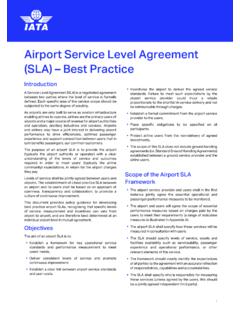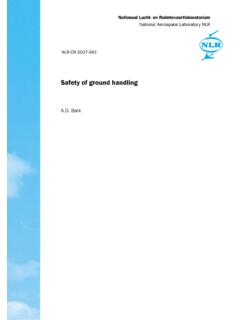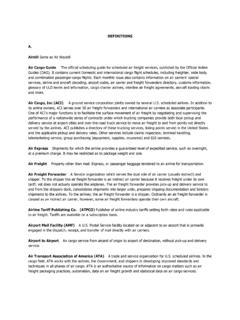Transcription of Unit 1: The UK Aviation Industry - Edexcel
1 Unit 1: The UK Aviation Industry Unit code: T/504/2278. QCF Level 3: BTEC Nationals Credit value: 10. Guided learning hours: 60. Aim and purpose The aim of this unit is to give learners knowledge and understanding of the scale of UK Aviation and the role of organisations within the Industry . Unit introduction This unit is an invaluable and interesting starting point in a learner's study of the Aviation Industry , as it enables them to investigate the Industry holistically. Learners start by examining the scale of the Industry , which will put the Industry into context and emphasise its relative importance to the UK. The diverse nature of airlines is explored next and how their di erent services serve di erent markets. Airports are investigated by examining their location, their facilities and their ownership before looking in detail at their di erent characteristics.
2 The Aviation Industry is governed and supported by a strict regulatory regime covering safety and security issues, and these regulatory organisations are backed-up by a number of trade associations that co-ordinate activities in these and other areas to serve the best interests of the di erent Industry sectors. The Industry would not function without a vast array of ancillary organisations that supply vital products and services in a number of specialist areas from aircraft manufacturing for airlines to tax-free shopping for passengers. Nine out of every ten ights in the UK are general Aviation (GA) ights. However, GA is a sector of the Industry that most learners give very little thought to. An exploration of the organisations that make up this hugely important sector concludes the unit.
3 Learning outcomes On completion of this unit a learner should: 1 Know the scale of the UK Aviation Industry and how it contributes to the UK economy 2 Understand the operating characteristics of commercial airlines 3 Understand the di erent types of UK airport, their ownership and characteristics 4 Understand the contribution of general Aviation operations to the UK Aviation Industry 5 Understand how regulatory bodies, trade associations and ancillary organisations support the Aviation Industry . The UK Aviation Industry Pearson BTEC Nationals (QCF) speci cation in Aviation Operations Issue 2 November 2019 Pearson Education Limited 2012. 1. Unit content 1 Know the scale of the UK Aviation Industry and how it contributes to the UK economy Scale of the UK Aviation Industry : million passengers per annum (mppa) (UK total, by UK airport, by UK airline, domestic and international total, international destinations to and from the UK by country leading ve by CAA.)
4 Statistics). non-passenger indicators (number of air transport movements (ATMs), cargo tonnes uplifted). major changes and trends over the last ten years, growth of regional airports nancial scale, major airline operating revenues, major airline operating expenses, major airline operating pro t or loss, changes and trends, currency exchange and impact on airlines as fuel purchased in US dollars, eet grounding and impact on airlines employment gures, airports, airlines contribution to UK gross domestic product (GDP), UK airline passenger duties are among the highest in the world 2 Understand the operating characteristics of commercial airlines Types of commercial airlines: full service scheduled low-cost scheduled charter cargo, scheduled, charter, integrated Operating characteristics.
5 Aircraft types, manufacturers, characteristics, crew and ground handling requirements route networks, long/short haul, hub and spoke, point to point, international/domestic fares and conditions of travel, exibility, seat selection, baggage allowances class options and service levels timetables distribution, bookings 3 Understand the di erent types of UK airport, their ownership and characteristics UK airports: geographical location major, London Heathrow regional, Newcastle local, Blackpool ownership (public, private, public/private partnership, group). 2 The UK Aviation Industry Pearson BTEC Nationals (QCF) speci cation in Aviation Operations Issue 2 November 2019 Pearson Education Limited 2012. UK airport characteristics: route network number and type of airlines number of passengers cargo tonnes passenger facilities and services, car parks, shops, restaurants, executive lounges, hotels operational facilities and services (runways, passenger terminals, cargo terminals, handling agents).
6 Scale and location of general Aviation operations 4 Understand the contribution of general Aviation operations to the UK Aviation Industry Types of general Aviation organisations: aircraft operator, ight school, club, executive transport, air taxi, oil Industry support, emergency service air eld operator, private strip, GA terminal at regional airport management and control, Air Tra c Control, Border Control, Air eld management Aircraft types used by general Aviation organisations: manufacturers, Cessna, Piper, Bell, Boeing, Gulfstream characteristics, xed wing, rotary, passenger capacity, cargo capacity range, take-o /landing performance requirements, crew number, quali cations, ground handling General Aviation operations: ownership types, private (business, pleasure), club, corporate, fractional pilot training, school, private, commercial recreational, ying club, gliding, parachute, aerobatics, microlight commercial operation, business, air taxi, charter, survey, agricultural, emergency services, police, ambulance oil Industry support, xed wing, rotary ground support, air eld management, aircraft management, GA terminals at major airports relationships with regulatory and statutory bodies, Air Tra c Control, UK Border Force, CAA.
7 Links with other Aviation organisations, air eld operators, commercial airlines The UK Aviation Industry Pearson BTEC Nationals (QCF) speci cation in Aviation Operations Issue 2 November 2019 Pearson Education Limited 2012. 3. 5 Understand how regulatory bodies, trade associations and ancillary organisations support the Aviation Industry Role of regulatory bodies, in relation to Aviation : role of regulatory bodies (to establish the rules and regulations that govern the Industry , to promulgate rules and regulations and to ensure compliance with rules and regulations). International Civil Aviation Organization (ICAO). Civil Aviation Authority (CAA). UK Border Force National Air Tra c Service (NATS). police Department for Transport security (TRANSEC).
8 Role of trade associations: role of trade associations (to promote and support the interests of Industry ). International Air Transport Association (IATA). Airports Council International (ACI). British Air Transport Association (BATA). British Business and General Aviation Association (BBGA). Role of ancillary organisations in relation to supporting the Aviation Industry : role of ancillary organisations (to provide goods and services to the Aviation Industry ). aircraft manufacturers engine manufacturers airline engineering and maintenance companies in- ight catering companies fuel suppliers cleaning companies handling agents retail operations, shops and restaurants in airport, currency exchange, airport lounges onward travel, car rental, taxi, public transport car parking operators (on site, o site).
9 Tour operators, travel agents freight forwarders 4 The UK Aviation Industry Pearson BTEC Nationals (QCF) speci cation in Aviation Operations Issue 2 November 2019 Pearson Education Limited 2012. Assessment and grading criteria In order to pass this unit, the evidence that the learner presents for assessment needs to demonstrate that they can meet all the learning outcomes for the unit. The assessment criteria for a pass grade describe the level of achievement required to pass this unit. Assessment and grading criteria To achieve a pass grade the To achieve a merit grade the To achieve a distinction grade evidence must show that the evidence must show that, in the evidence must show that, learner is able to: addition to the pass criteria, in addition to the pass and the learner is able to: merit criteria, the learner is able to.
10 P1 Describe the scale of the UK M1 Explain major Aviation D1 Discuss the scale of the Aviation Industry , including Industry changes and trends Industry commenting passenger, cargo, nancial in relation to scale and on trends, operating and employment data [IE] contribution to UK economy characteristics and the organisations within it P2 Identify major UK Aviation Industry changes and trends P3 Describe di erent types of M2 Discuss why an airline might commercial airlines base its operation from a particular airport P4 Compare the operating characteristics of di erent commercial airlines P5 Describe di erent types of UK airports and their ownership P6 Compare the operating characteristics of di erent types of airports P7 Explain how general Aviation M3 Analyse the role of three organisations operate di erent types of general Aviation organisations, highlighting their links with other Aviation sectors P8 Analyse the role of M4 Evaluate the roles of regulatory bodies regulatory bodies.














